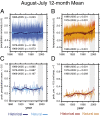Anthropogenic warming has increased drought risk in California
- PMID: 25733875
- PMCID: PMC4386330
- DOI: 10.1073/pnas.1422385112
Anthropogenic warming has increased drought risk in California
Abstract
California is currently in the midst of a record-setting drought. The drought began in 2012 and now includes the lowest calendar-year and 12-mo precipitation, the highest annual temperature, and the most extreme drought indicators on record. The extremely warm and dry conditions have led to acute water shortages, groundwater overdraft, critically low streamflow, and enhanced wildfire risk. Analyzing historical climate observations from California, we find that precipitation deficits in California were more than twice as likely to yield drought years if they occurred when conditions were warm. We find that although there has not been a substantial change in the probability of either negative or moderately negative precipitation anomalies in recent decades, the occurrence of drought years has been greater in the past two decades than in the preceding century. In addition, the probability that precipitation deficits co-occur with warm conditions and the probability that precipitation deficits produce drought have both increased. Climate model experiments with and without anthropogenic forcings reveal that human activities have increased the probability that dry precipitation years are also warm. Further, a large ensemble of climate model realizations reveals that additional global warming over the next few decades is very likely to create ∼ 100% probability that any annual-scale dry period is also extremely warm. We therefore conclude that anthropogenic warming is increasing the probability of co-occurring warm-dry conditions like those that have created the acute human and ecosystem impacts associated with the "exceptional" 2012-2014 drought in California.
Keywords: CMIP5; climate change detection; climate extremes; drought; event attribution.
Conflict of interest statement
The authors declare no conflict of interest.
Figures




Comment in
-
Climate change and California drought in the 21st century.Proc Natl Acad Sci U S A. 2015 Mar 31;112(13):3858-9. doi: 10.1073/pnas.1503667112. Epub 2015 Mar 23. Proc Natl Acad Sci U S A. 2015. PMID: 25829537 Free PMC article. No abstract available.
References
-
- US Census Bureau State and County QuickFacts. 2014 Available at quickfacts.census.gov/qfd/states/06000.html.
-
- US Bureau of Economic Analysis Bureau of Economic Analysis Interactive Data. 2014 Available at www.bea.gov/
-
- US Department of Agriculture CALIFORNIA Agricultural Statistics 2012 Crop Year. 2013 Available at www.nass.usda.gov/Statistics_by_State/California/Publications/California....
-
- Myers N, Mittermeier RA, Mittermeier CG, da Fonseca GAB, Kent J. Biodiversity hotspots for conservation priorities. Nature. 2000;403(6772):853–858. - PubMed
-
- Hanak E, et al. Managing California’s Water: From Conflict to Reconciliation. Public Policy Institute of California; San Francisco: 2011.
Publication types
MeSH terms
Grants and funding
LinkOut - more resources
Full Text Sources
Other Literature Sources
Miscellaneous

